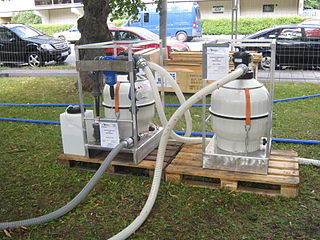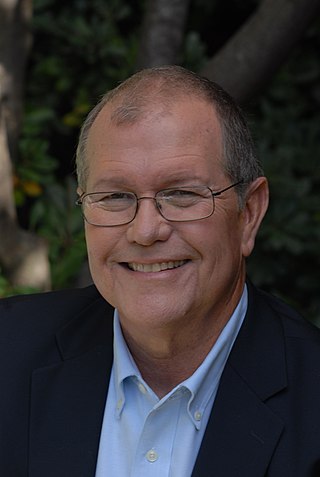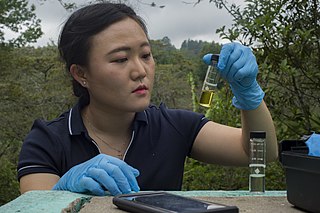
Sodium hypochlorite, commonly known in a dilute solution as (chlorine) bleach, is an inorganic chemical compound with the formula NaOCl, comprising a sodium cation and a hypochlorite anion. It may also be viewed as the sodium salt of hypochlorous acid. The anhydrous compound is unstable and may decompose explosively. It can be crystallized as a pentahydrate NaOCl·5H
2O, a pale greenish-yellow solid which is not explosive and is stable if kept refrigerated.

Water purification is the process of removing undesirable chemicals, biological contaminants, suspended solids, and gases from water. The goal is to produce water that is fit for specific purposes. Most water is purified and disinfected for human consumption, but water purification may also be carried out for a variety of other purposes, including medical, pharmacological, chemical, and industrial applications. The history of water purification includes a wide variety of methods. The methods used include physical processes such as filtration, sedimentation, and distillation; biological processes such as slow sand filters or biologically active carbon; chemical processes such as flocculation and chlorination; and the use of electromagnetic radiation such as ultraviolet light.

Water treatment is any process that improves the quality of water to make it appropriate for a specific end-use. The end use may be drinking, industrial water supply, irrigation, river flow maintenance, water recreation or many other uses, including being safely returned to the environment. Water treatment removes contaminants and undesirable components, or reduces their concentration so that the water becomes fit for its desired end-use. This treatment is crucial to human health and allows humans to benefit from both drinking and irrigation use.

Chlorine dioxide is a chemical compound with the formula ClO2 that exists as yellowish-green gas above 11 °C, a reddish-brown liquid between 11 °C and −59 °C, and as bright orange crystals below −59 °C. It is usually handled as an aqueous solution. It is also commonly used as a bleach. More recent developments have extended its applications in food processing and as a disinfectant.

A disinfectant is a chemical substance or compound used to inactivate or destroy microorganisms on inert surfaces. Disinfection does not necessarily kill all microorganisms, especially resistant bacterial spores; it is less effective than sterilization, which is an extreme physical or chemical process that kills all types of life. Disinfectants are generally distinguished from other antimicrobial agents such as antibiotics, which destroy microorganisms within the body, and antiseptics, which destroy microorganisms on living tissue. Disinfectants are also different from biocides—the latter are intended to destroy all forms of life, not just microorganisms. Disinfectants work by destroying the cell wall of microbes or interfering with their metabolism. It is also a form of decontamination, and can be defined as the process whereby physical or chemical methods are used to reduce the amount of pathogenic microorganisms on a surface.
Campden tablets are a sulphur-based product that is used primarily to sterilize wine, cider and in beer making to kill bacteria and to inhibit the growth of most wild yeast: this product is also used to eliminate both free chlorine and the more stable form, chloramine, from water solutions. Campden tablets allow the amateur brewer to easily measure small quantities of sodium metabisulfite, so it can be used to protect against wild yeast and bacteria without affecting flavour. Untreated cider must frequently suffers from acetobacter contamination causing vinegar spoilage. Yeasts are resistant to the tablets but the acetobacter are easily killed off, hence treatment is important in cider production.

Total organic carbon (TOC) is an analytical parameter representing the concentration of organic carbon in a sample. TOC determinations are made in a variety of application areas. For example, TOC may be used as a non-specific indicator of water quality, or TOC of source rock may be used as one factor in evaluating a petroleum play. For marine surface sediments average TOC content is 0.5% in the deep ocean, and 2% along the eastern margins.
Monochloramine, often called chloramine, is the chemical compound with the formula NH2Cl. Together with dichloramine (NHCl2) and nitrogen trichloride (NCl3), it is one of the three chloramines of ammonia. It is a colorless liquid at its melting point of −66 °C (−87 °F), but it is usually handled as a dilute aqueous solution, in which form it is sometimes used as a disinfectant. Chloramine is too unstable to have its boiling point measured.

Portable water purification devices are self-contained, easily transported units used to purify water from untreated sources for drinking purposes. Their main function is to eliminate pathogens, and often also of suspended solids and some unpalatable or toxic compounds.

Electrolysed water is produced by the electrolysis of ordinary tap water containing dissolved sodium chloride. The electrolysis of such salt solutions produces a solution of hypochlorous acid and sodium hydroxide. The resulting water can be used as a disinfectant.
Swimming pool sanitation is the process of ensuring healthy conditions in swimming pools. Proper sanitation is needed to maintain the visual clarity of water and to prevent the transmission of infectious waterborne diseases.

Bleach is the generic name for any chemical product that is used industrially or domestically to remove color (whitening) from a fabric or fiber or to clean or to remove stains in a process called bleaching. It often refers specifically to a dilute solution of sodium hypochlorite, also called "liquid bleach".
Disinfection by-products (DBPs) result from chemical reactions between organic and inorganic matter in water with chemical treatment agents during the water disinfection process.
Drinking water quality in the United States is generally safe. In 2016, over 90 percent of the nation's community water systems were in compliance with all published U.S. Environmental Protection Agency (EPA) standards. Over 286 million Americans get their tap water from a community water system. Eight percent of the community water systems—large municipal water systems—provide water to 82 percent of the US population.
CT Values are an important part of calculating disinfectant dosage for the chlorination of drinking water. A CT value is the product of the concentration of a disinfectant and the contact time with the water being disinfected. It is typically expressed in units of mg-min/L.

Michael John McGuire is an American environmental engineer and writer whose career has focused on drinking water quality improvement. He has been recognized for his expertise in the control of trace organic and inorganic contaminants and microbial pathogens in water. He is also known for his work in the identification, control and treatment of taste and odor problems in drinking water. He has published numerous articles in professional journals and he has been the co-editor of five books and compilations of articles. He published a book that documented the first continuous disinfection of a drinking water supply in the U.S. With Marie S. Pearthree, he wrote a book on the corrosive water debacle in Tucson, Arizona in 1992–94. He has been active in the American Water Works Association, and he has served as a volunteer and officer in that organization. In 2009, he was elected to the National Academy of Engineering.

Water chlorination is the process of adding chlorine or chlorine compounds such as sodium hypochlorite to water. This method is used to kill bacteria, viruses and other microbes in water. In particular, chlorination is used to prevent the spread of waterborne diseases such as cholera, dysentery, and typhoid.
Mixed oxidant solution is a type of disinfectant which is used for disinfecting, sterilization and eliminating pathogenic microorganisms in water and in many other applications. Using a mixed oxidant solution for water disinfection, compared to other methods, may have various benefits such as higher disinfecting power, stable residual chlorine in water, improved taste and smell, elimination of biofilm, and safety. A mixed-oxidant solution is produced by electrolysis of sodium chloride and is a mixture of disinfecting compounds. The main component of this product is chlorine and its derivatives (ClO−, HClO and Cl2 solution). It may also contain high amounts of chlorine dioxide solution, dissolved ozone, hydrogen peroxide, and oxygen, from which the name "mixed oxidant" is derived.

Chlorine-releasing compounds, also known as chlorine base compounds, is jargon to describe certain chlorine-containing substances that are used as disinfectants and bleaches. They include the following chemicals: sodium hypochlorite, chloramine, halazone, and sodium dichloroisocyanurate. They are widely used to disinfect water and medical equipment, and surface areas as well as bleaching materials such as cloth. The presence of organic matter can make them less effective as disinfectants. They come as a liquid solution, or as a powder that is mixed with water before use.

Stuart William Krasner, was the Principal Environmental Specialist (retired) with the Metropolitan Water District of Southern California, at the Water Quality Laboratory located in La Verne, California. In his 41 years with Metropolitan, he made revolutionary changes in the field's understanding of how disinfection by-products occur, are formed and how they can be controlled in drinking water. His research contributions include the study of emerging DBPs including those associated with chlorine, chloramines, ozone, chlorine dioxide and bromide/iodide-containing waters. He made groundbreaking advances in understanding the watershed sources of pharmaceuticals and personal care products (PPCPs) and wastewater impacts on drinking-water supplies. For DBPs and PPCPs, he developed analytical methods and occurrence data and he provided technical expertise for the development of regulations for these drinking water contaminants. In the early 1990s, Krasner developed the 3x3 matrix illustrating removal of total organic carbon from drinking water as a function of water alkalinity and initial total organic carbon concentration. The matrix was revised by him and included in the USEPA Stage 1 D/DBP regulation as the enhanced coagulation requirement. Every water utility in the U.S. that is subject to this regulation is required to meet total organic carbon removal requirements along with their exceptions.











